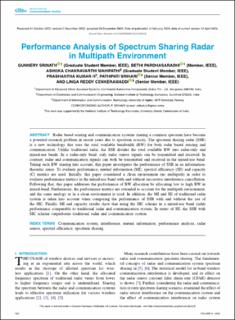| dc.contributor.author | Gunnery, Srinath | |
| dc.contributor.author | Bethi, Pardhasaradhi | |
| dc.contributor.author | Mahipathi, Ashoka Chakravarthi | |
| dc.contributor.author | H, Prashantha Kumar | |
| dc.contributor.author | Pathipati, Srihari | |
| dc.contributor.author | Cenkeramaddi, Linga Reddy | |
| dc.date.accessioned | 2024-04-16T10:22:04Z | |
| dc.date.available | 2024-04-16T10:22:04Z | |
| dc.date.created | 2023-02-03T22:21:48Z | |
| dc.date.issued | 2023 | |
| dc.identifier.citation | Gunnery, S., Bethi, P., Mahipathi, A. C., H, P. K., Pathipati, S. & Cenkeramaddi, L. R. (2023). Performance Analysis of Spectrum Sharing Radar in Multipath Environment. IEEE Open Journal of the Communications Society, 4, 922-935. | en_US |
| dc.identifier.issn | 2644-125X | |
| dc.identifier.uri | https://hdl.handle.net/11250/3126754 | |
| dc.description.abstract | Radar based sensing and communication systems sharing a common spectrum have become a potential research problem in recent years due to spectrum scarcity. The spectrum sharing radar (SSR) is a new technology that uses the total available bandwidth (BW) for both radar based sensing and communication. Unlike traditional radar, the SSR divides the total available BW into radar-only and mixed-use bands. In a radar-only band, only radar sensor signals can be transmitted and received. In contrast, radar and communication signals can both be transmitted and received in the mixed-use band. Taking such BW sharing into account, this paper investigates the performance of SSR in an information-theoretic sense. To evaluate performance, mutual information (MI), spectral efficiency (SE) and capacity (C) metrics are used. Initially, this paper considered a clean environment (no multipath) in order to evaluate performance metrics in the mixed-use band with and without successive interference cancellation. Following that, this paper addresses the performance of BW allocation by allocating low to high BW in mixed-band. Furthermore, the performance metrics are extended to account for the multipath environment, and the same analogy as in a clean environment is used. In addition, the MI and SE of traditional radar system is taken into account when comparing the performance of SSR with and without the use of the SIC. Finally, MI and capacity results show that using the SIC scheme in a mixed-use band yields performance comparable to traditional radar and communication system. In terms of SE, the SSR with SIC scheme outperforms traditional radar and communication system. | en_US |
| dc.language.iso | eng | en_US |
| dc.publisher | IEEE | en_US |
| dc.rights | Navngivelse 4.0 Internasjonal | * |
| dc.rights.uri | http://creativecommons.org/licenses/by/4.0/deed.no | * |
| dc.title | Performance Analysis of Spectrum Sharing Radar in Multipath Environment | en_US |
| dc.title.alternative | Performance Analysis of Spectrum Sharing Radar in Multipath Environment | en_US |
| dc.type | Peer reviewed | en_US |
| dc.type | Journal article | en_US |
| dc.description.version | publishedVersion | en_US |
| dc.rights.holder | © 2023 The Author(s) | en_US |
| dc.subject.nsi | VDP::Teknologi: 500::Informasjons- og kommunikasjonsteknologi: 550 | en_US |
| dc.source.pagenumber | 922-935 | en_US |
| dc.source.volume | 4 | en_US |
| dc.source.journal | IEEE Open Journal of the Communications Society | en_US |
| dc.identifier.doi | https://doi.org/10.1109/OJCOMS.2023.3240116 | |
| dc.identifier.cristin | 2122967 | |
| dc.relation.project | Norges forskningsråd: 280835 | en_US |
| dc.relation.project | Norges forskningsråd: 287918 | en_US |
| cristin.qualitycode | 1 | |

